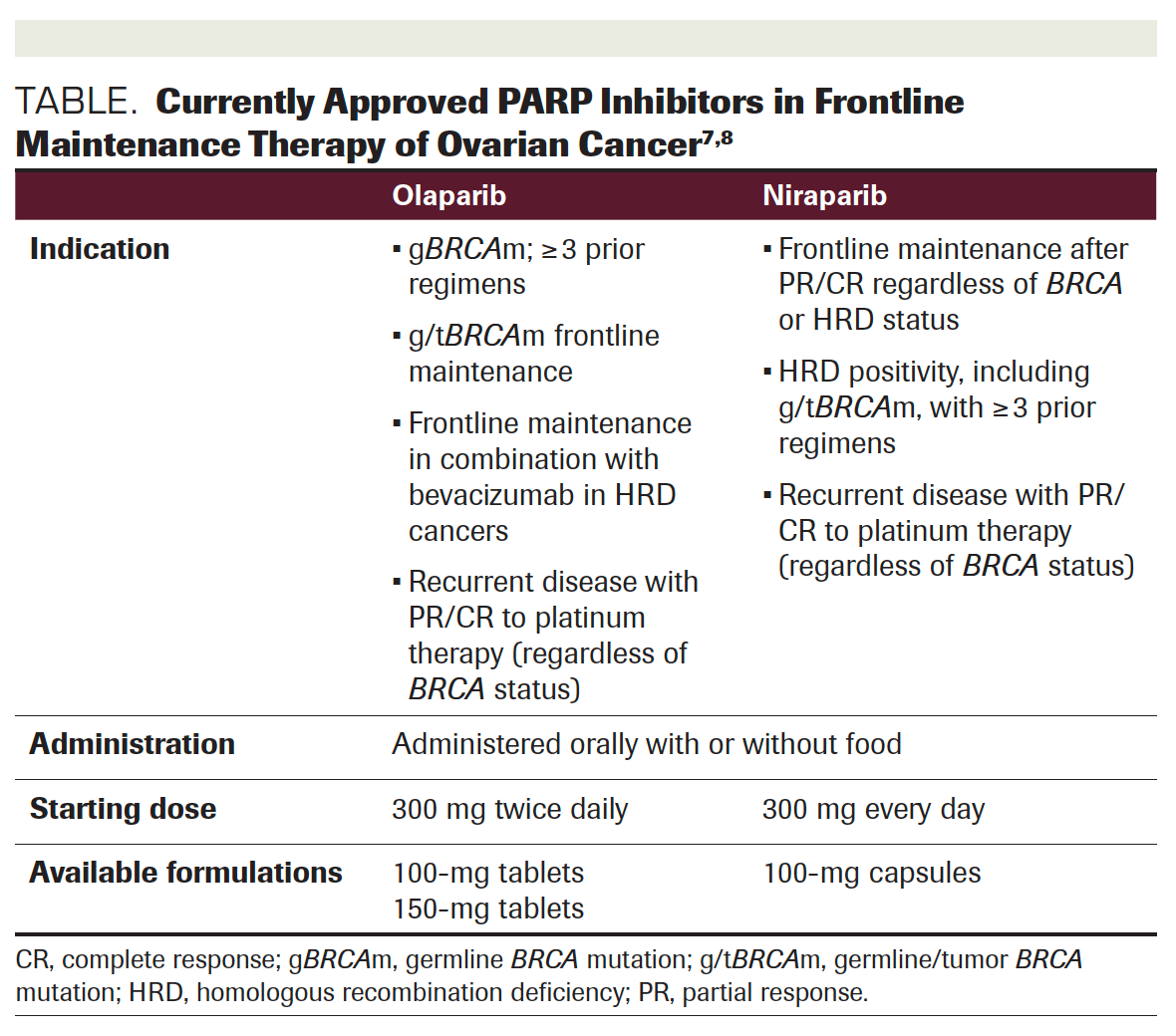Using PARP Inhibitors in Frontline Maintenance Therapy for Ovarian Cancer
The use of PARP inhibitors in frontline maintenance therapy has greatly reduced the risk of recurrence in patients with ovarian cancer.
Ovarian cancer is the leading cause of mortality among gynecologic cancers in the United States,1 expected to result in roughly 13,940 deaths in 2020.2 Between 2008 and 2017, mortality decreased by 2.3% per year. Incidence rates also decreased, with a 1.6% drop per year from 2007 to 2016. In 2020, an estimated 21,750 new cases of ovarian cancer will be diagnosed. The majority (90%) of ovarian cancers are epithelial ovarian cancer—often high-grade serous adenomas, which are associated with a poor prognosis and have the fewest known risk factors.2
Frontline Maintenance Therapy
Most patients with newly diagnosed ovarian cancer have no evidence of disease after standard treatment with surgery and platinum-based chemotherapy.3 However, up to 85% of patients experience disease recurrence that requires additional treatment.4 To help prevent ovarian cancer from returning following a response to initial therapy, maintenance therapies—such as PARP inhibitors—have been developed. PARP inhibitors interfere with the molecular events needed for DNA repair and appear to have the strongest effect on cancers with BRCA gene
mutations or BRCA-ness phenotype.5,6
Currently Approved PARP Inhibitors in Frontline Maintenance Therapy
for Ovarian Cancer
Two PARP inhibitors—olaparib and niraparib—are currently approved for frontline maintenance therapy of ovarian cancer (Table7,8).
Olaparib is approved for frontline maintenance therapy in adult patients with a complete response (CR) or partial response (PR) to platinum-based chemotherapy and with deleterious or suspected deleterious germline or somatic BRCA gene mutation–positive advanced epithelial ovarian, fallopian tube, or primary peritoneal cancer.7 This approval was based on the results of the randomized phase 3 SOLO-1 trial (NCT01844986).9 Trial results indicate olaparib was associated with a 60% rate of freedom from disease progression and death at 3 years compared with 27% in placebo (95% CI, 0.23-0.41; P < .001) in patients with suspected or confirmed BRCA gene mutation–positive cancer.10 This translates to a 70% reduction in risk of disease progression or death in patients treated with olaparib versus placebo for frontline maintenance therapy.10 Results from a subgroup analysis of the SOLO-1 outcomes showed a benefit of using olaparib over placebo in all subgroups of patients with newly diagnosed BRCA1/2 gene mutation–positive advanced ovarian cancer studied, regardless of initial surgical outcome, chemotherapy response, or BRCA mutation type.3
Currently Approved PARP Inhibitors in Frontline Maintenance Therapy of Ovarian Cancer

Serious adverse events (AEs) in the SOLO-1 trial occurred in 21% of patients receiving olaparib versus 12% in the placebo group, the most common of which was anemia (7% vs 0%, respectively). None of the AEs that occurred during trial intervention, or up to 30 days from discontinuation, resulted in death. AEs were often managed by dose reduction or interruption, but discontinuation was occasionally necessary, most often because of nausea and anemia. Acute myeloid leukemia and pneumonitis or interstitial lung disease appeared to occur at a higher incidence with olaparib use compared with placebo (1% vs 0% and 2% vs 0%, respectively).10
Olaparib is also approved for use in combination with bevacizumab as frontline maintenance treatment in adult patients with homologous recombination deficiency (HRD)-positive advanced epithelial ovarian, fallopian tube, or primary peritoneal cancer who are in CR/PR to platinum based chemotherapy plus bevacizumab7; this approval was based on the results of the randomized, phase 3 PAOLA-1 trial (NCT02477644).11 In the trial, the addition of olaparib to bevacizumab was an effective frontline maintenance therapy in patients who had responded to platinum based chemotherapy and bevacizumab, showing a significant benefit in median progression-free survival (PFS) in HRD positive cancers over placebo plus bevacizumab, regardless of BRCA mutation status (22.1 vs 16.6 months;95% CI, 0.49-0.72; P < .001).12 In the subgroup of patients with BRCA gene mutation-positive cancers, the PFS benefit was even more profound (HR for disease progression or death, 0.31; 95% CI, 0.20-0.47), which was comparable to results observed in the SOLO-1 trial (HR, 0.30; 95% CI, 0.23-0.41).
In PAOLA-1, serious AEs occurred in 31% of patients in both groups being studied, and the most common serious AE associated with the addition of olaparib to bevacizumab was anemia, occurring in 6% of patients in this group (vs < 1% of patients in the placebo plus bevacizumab group). Myelodysplastic syndromes, acute myeloid leukemia, or aplastic anemia occurred in 6 of 535 (1%) patients receiving olaparib plus bevacizumab and in 1 of 267 (< 1%) of patients receiving placebo plus bevacizumab. Grade 1 or 2 pneumonitis, interstitial lung disease, or bronchiolitis also occurred in 1% of patients receiving olaparib plus bevacizumab versus no patients receiving placebo plus bevacizumab.12
Niraparib indications include frontline maintenance treatment in adult patients with advanced epithelial ovarian, fallopian tube, or primary peritoneal cancer who are in CR/PR after first-line platinum-based chemotherapy.8 This frontline maintenance approval is based on results of the randomized, phase 3 PRIMA trial (NCT02655016),13 which evaluated the efficacy of niraparib versus placebo as frontline maintenance therapy for newly diagnosed advanced ovarian cancer after response to platinum-based chemotherapy. The use of niraparib was associated with a significant improvement in median PFS in patients who were HRD positive (21.9 vs 10.4 months, respectively; 95% CI, 0.31-0.59; P < .001), as well as in the overall population (13.8 vs 8.2 months; 95% CI, 0.50-0.76; P < .001).4
In the PRIMA trial, the most common grade 3 or higher AEs included anemia (31.0%), thrombocytopenia (28.7%), and neutropenia (12.8%). No treatment-related deaths occurred during the trial.4
Considerations for the Use of PARP Inhibitors as Frontline Maintenance Therapy
The updated 2020 National Comprehensive Cancer Network (NCCN) guidelines for ovarian cancer recommend PARP inhibitors for frontline maintenance therapy in stages II, III, and IV epithelial ovarian, fallopian tube, and primary peritoneal cancers that have either the BRCA1/2 wild-type, a BRCA1/2 mutation, or an unknown status. For those without a BRCA1/2 mutation, identifying HRD status may help determine the potential benefit of PARP inhibitors. Before receiving PARP inhibitors, patients should first undergo cytoreductive surgery if possible. They should also be evaluated for appropriate timing for platinum-based chemotherapy (neoadjuvant vs postoperative) and whether bevacizumab should be added to the chemotherapy regimen. Patients must complete a primary therapy regimen and experience CR/PR to be evaluated for PARP inhibitor treatment.14
According to the NCCN guidelines, among patients who did not receive bevacizumab during primary therapy, niraparib (category 2A recommendation) is recommended for those with BRCA1/2 wild-type or unknown status and olaparib or niraparib (category 1) for those with a BRCA1/2 mutation. If a CR had been achieved with primary therapy without bevacizumab, observation alone should also be considered. Among patients who received bevacizumab as primary therapy, those with a BRCA1/2 wild-type or unknown status, bevacizumab plus olaparib or bevacizumab (category 2A) is recommended. Bevacizumab plus olaparib (category 1), or olaparib, or niraparib (category 2A) is recommended for those with a BRCA1/2 mutation.14 Administration of bevacizumab may be restricted for some patients because of concerns with safety, and olaparib alone is approved only for cancers with BRCA1/2 mutations; therefore, niraparib, which has demonstrated efficacy in wild-type BRCA tumors, can offer an important treatment strategy for some patients with limited options.4
Resistance to PARP inhibitors typically develops with most advanced ovarian cancers.6 Because the mechanisms contributing to PARP inhibitor resistance are the same mechanisms that contribute to platinum-based drug resistance, clinicians must carefully choose therapies administered before and after PARP inhibitor treatment. It is not yet fully known whether re-treating with a PARP inhibitor after discontinuation for reasons such as disease progression or AEs will lead to a different response to treatment.15 Results from an analysis of the QUADRA trial (N = 463; NCT02354586) conducted on a subset of heavily treated patients with recurrent ovarian cancer previously treated with PARP inhibitors (niraparib, rucaparib, olaparib, or veliparib; n = 37) showed that those who had discontinued PARP inhibitors because of progression experienced limited benefit from PARP inhibitor monotherapy retreatment with niraparib. Retreatment demonstrated a safety profile similar to that of the first treatment. Additional research is needed to determine the benefit of PARP inhibitor retreatment among patients who did not discontinue the first PARP inhibitor because of progression and whether it is safe for those who experienced AEs with the first PARP inhibitor.15
Conclusions
Ovarian cancer is a significant cause of morbidity and mortality for women worldwide. Many patients receive a diagnosis after metastasis of the cancer.1 With up to 85% of patients experiencing disease recurrence that requires additional treatment,4 olaparib and niraparib have played an important role in reducing the risk of recurrence since their approvals as maintenance therapies.7,8 Opportunities exist to research biomarkers that identify which patients could most benefit from treatment with PARP inhibitors, to deepen the understanding of PARP inhibitor resistance and biomarkers that may help predict resistance, and to identify PARP inhibitor combination therapies that work synergistically to prevent recurrence of ovarian cancer.6
REFERENCES
1. Ovarian cancer statistics. Centers for Disease Control and Prevention. Updated June 8, 2020. Accessed September 18, 2020. https://www.cdc.gov/cancer/ovarian/statistics/index.htm
2. ACS cancer facts and figures 2020. American Cancer Society. Accessed August 24, 2020. https://www.cancer.org/content/dam/cancer-org/research/cancer-facts-and-statistics/annual-cancer-facts-and-figures/2020/cancer-facts-and-figures-2020.pdf
3. DiSilvestro P, Colombo N, Scambia G, et al. Efficacy of maintenance olaparib for patients with newly diagnosed advanced ovarian cancer with a BRCA mutation: subgroup analysis findings from the SOLO1 trial. J Clin Oncol. Published online August 4, 2020. doi:10.1200/JCO.20.00799
4. González-Martín A, Pothuri B, Vergote I, et al; PRIMA/ENGOT-OV26/GOG-3012 Investigators. Niraparib in patients with newly diagnosed advanced ovarian cancer. N Engl J Med. 2019;381(25):2391-2402. doi:10.1056/NEJMoa1910962
5. Pan Z, Xie X. BRCA mutations in the manifestation and treatment of ovarian cancer. Oncotarget. 2017;8(57):97657-97670. doi:10.18632/oncotarget.18280
6. Lord CJ, Ashworth A. PARP inhibitors: synthetic lethality in the clinic. Science. 2017;355(6330):1152-1158. doi:10.1126/science.aam7344
7. Lynparza. Prescribing information. AstraZeneca Pharmaceuticals LP; 2020. Accessed August 26, 2020. https://www.azpicentral.com/lynparza_tb/lynparza_tb.pdf#page=1
8. Zejula. Prescribing information. GlaxoSmithKline; 2020. Accessed August 26, 2020. https://www.gsksource.com/pharma/content/dam/GlaxoSmithKline/US/en/Prescribing_Information/Zejula/pdf/ZEJULA-PI-PIL.PDF
9. Olaparib maintenance monotherapy in patients with BRCA mutated ovarian cancer following first line platinum based chemotherapy. (SOLO-1). ClinicalTrials.gov. Updated August 28, 2020. Accessed September 8, 2020. https://clinicaltrials.gov/ct2/show/NCT01844986
10. Moore K, Colombo N, Scambia G, et al. Maintenance olaparib in patients with newly diagnosed advanced ovarian cancer. N Engl J Med. 2018;379(26):2495-2505. doi:10.1056/NEJMoa1810858
11. Platine, Avastin and OLAparib in 1st line (PAOLA-1). ClinicalTrials.gov. Updated January 21, 2020. Accessed September 8, 2020. https://www.clinicaltrials.gov/ct2/show/NCT02477644
12. Ray-Coquard I, Pautier P, Pignata S, et al; PAOLA-1 Investigators. Olaparib plus bevacizumab as first-line maintenance in ovarian cancer. N Engl J Med. 2019;381(25):2416-2428. doi:10.1056/NEJMoa1911361
13. A study of niraparib maintenance treatment in patients with advanced ovarian cancer following response on front-line platinum-based chemotherapy. ClinicalTrials.gov. Updated August 14, 2020. Accessed September 9, 2020. https://clinicaltrials.gov/ct2/show/NCT02655016
14. NCCN. Clinical Practice Guidelines in Oncology. Ovarian cancer, version 1.2020. Accessed August 26, 2020. https://www.nccn.org/professionals/physician_gls/default.aspx#site
15. Rimel BJ, Secord AA, Geller MA, et al. Safety and efficacy results of retreatment with a PARP inhibitor monotherapy in late-line recurrent ovarian cancer: results from a subset of the QUADRA trial. Gynecol Oncol. 2020;156(3):e4-e5. doi:10.1016/j.ygyno.2019.11.045R

Newsletter
Stay up to date on recent advances in the multidisciplinary approach to cancer.